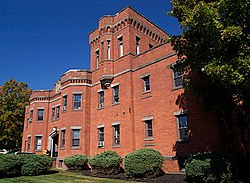History
In 1909, city officials from Willimantic petitioned the Connecticut General Assembly for funding to construct a modern armory. Despite opposition from a few senators concerned about the expansion of military infrastructure, the bill passed, allocating $50,000 for the construction of a single-company armory. A 300-by-160-foot lot was purchased from Samuel Chesbro for $6,500, and the architectural firm Whiton & McMahon was awarded the design contract. The builder, F. D. Kent, received $32,405 for construction. [2]
The armory originally housed Company B of the 169th Infantry until the 1960s, when it was reassigned to the 248th Engineer Company. The facility remained the home of the 248th until the late 1970s, when a new armory was constructed in Norwich, Connecticut, and the unit was relocated. [2]
Following its closure, the Willimantic Armory was sold to developers who converted the building into apartments, preserving the exterior while renovating the interior, eliminating most traces of the original design. [2]
The armory was added to the National Register of Historic Places in 1985. [1]
This page is based on this
Wikipedia article Text is available under the
CC BY-SA 4.0 license; additional terms may apply.
Images, videos and audio are available under their respective licenses.




